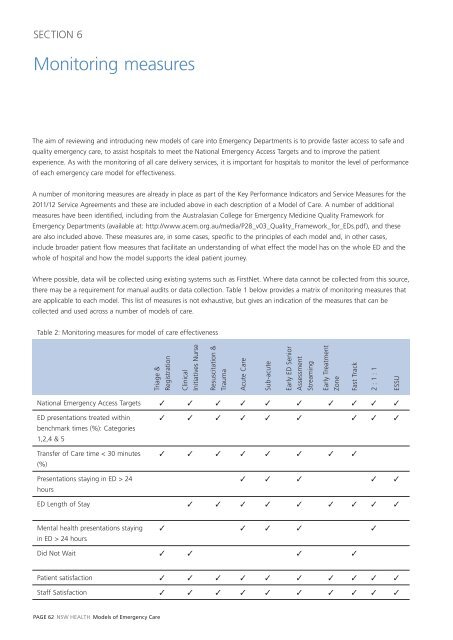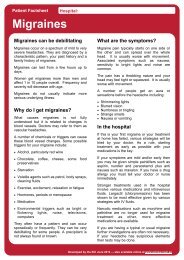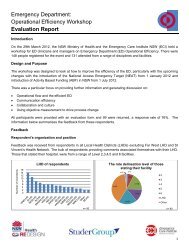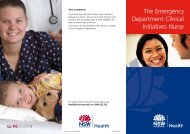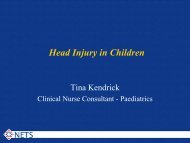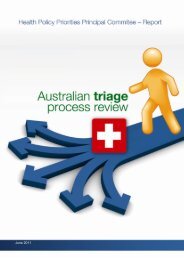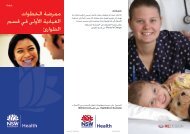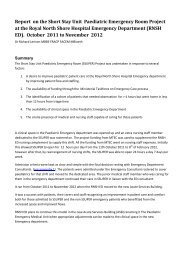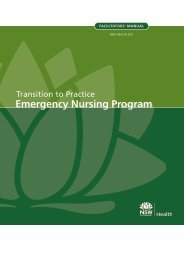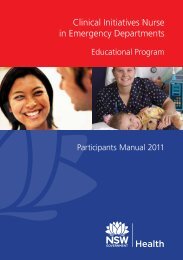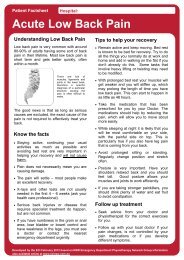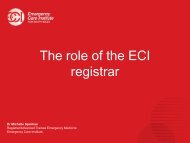Emergency Department Models of Care 2012 - NSW Health
Emergency Department Models of Care 2012 - NSW Health
Emergency Department Models of Care 2012 - NSW Health
- No tags were found...
You also want an ePaper? Increase the reach of your titles
YUMPU automatically turns print PDFs into web optimized ePapers that Google loves.
SECTION 6Monitoring measuresThe aim <strong>of</strong> reviewing and introducing new models <strong>of</strong> care into <strong>Emergency</strong> <strong>Department</strong>s is to provide faster access to safe andquality emergency care, to assist hospitals to meet the National <strong>Emergency</strong> Access Targets and to improve the patientexperience. As with the monitoring <strong>of</strong> all care delivery services, it is important for hospitals to monitor the level <strong>of</strong> performance<strong>of</strong> each emergency care model for effectiveness.A number <strong>of</strong> monitoring measures are already in place as part <strong>of</strong> the Key Performance Indicators and Service Measures for the2011/12 Service Agreements and these are included above in each description <strong>of</strong> a Model <strong>of</strong> <strong>Care</strong>. A number <strong>of</strong> additionalmeasures have been identified, including from the Australasian College for <strong>Emergency</strong> Medicine Quality Framework for<strong>Emergency</strong> <strong>Department</strong>s (available at: http://www.acem.org.au/media/P28_v03_Quality_Framework_for_EDs.pdf), and theseare also included above. These measures are, in some cases, specific to the principles <strong>of</strong> each model and, in other cases,include broader patient flow measures that facilitate an understanding <strong>of</strong> what effect the model has on the whole ED and thewhole <strong>of</strong> hospital and how the model supports the ideal patient journey.Where possible, data will be collected using existing systems such as FirstNet. Where data cannot be collected from this source,there may be a requirement for manual audits or data collection. Table 1 below provides a matrix <strong>of</strong> monitoring measures thatare applicable to each model. This list <strong>of</strong> measures is not exhaustive, but gives an indication <strong>of</strong> the measures that can becollected and used across a number <strong>of</strong> models <strong>of</strong> care.Table 2: Monitoring measures for model <strong>of</strong> care effectivenessTriage &RegistrationClinicalInitiatives NurseResuscitation &TraumaAcute <strong>Care</strong>Sub-acuteEarly ED SeniorAssessmentStreamingEarly TreatmentZoneFast Track2 : 1 : 1ESSUNational <strong>Emergency</strong> Access Targets ✓ ✓ ✓ ✓ ✓ ✓ ✓ ✓ ✓ ✓ED presentations treated withinbenchmark times (%): Categories1,2,4 & 5Transfer <strong>of</strong> <strong>Care</strong> time < 30 minutes(%)Presentations staying in ED > 24hours✓ ✓ ✓ ✓ ✓ ✓ ✓ ✓ ✓✓ ✓ ✓ ✓ ✓ ✓ ✓ ✓✓ ✓ ✓ ✓ ✓ED Length <strong>of</strong> Stay ✓ ✓ ✓ ✓ ✓ ✓ ✓ ✓ ✓Mental health presentations stayingin ED > 24 hours✓ ✓ ✓ ✓ ✓Did Not Wait ✓ ✓ ✓ ✓Patient satisfaction ✓ ✓ ✓ ✓ ✓ ✓ ✓ ✓ ✓ ✓Staff Satisfaction ✓ ✓ ✓ ✓ ✓ ✓ ✓ ✓ ✓ ✓PAGE 62 <strong>NSW</strong> HEALTH <strong>Models</strong> <strong>of</strong> <strong>Emergency</strong> <strong>Care</strong>


